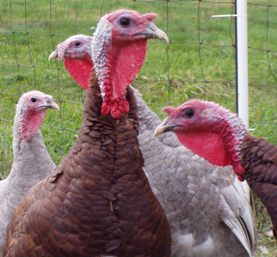 OK. So, you decided to go the distance for Thanksgiving and you got what the grower claimed was a Heritage Breed Turkey.
OK. So, you decided to go the distance for Thanksgiving and you got what the grower claimed was a Heritage Breed Turkey.
Now, what the heck do you do with it?
Well, first of all, what breed WAS it, exactly? Here’s a list of what are the ‘for-real, gen-u-wine’ heritage breeds.Heritage Turkeys If what you got is not on that list, then what you got was not a heritage breed. It was probably a bird derived from what is referred to as ‘broad breasted white’. The photo at the top of this shows the turkeys we raised this year; the grey ones are “Slate Blues”; the brown ones are “Bourbon Reds”.
Broad breasted Whites are to turkeys what Cornish Crosses are to chickens. They are the ‘industrial’ turkey bred to grow fast, get processed young, have a huge amount of white meat. They are eating machines. They are the sumo wrestlers of turkey-dom. They can’t move very much. They have chronic disease problems (no, I am not going to go after anyone about being a couch potato – we’re talking turkey breeding here). They have no more resemblance to that painting on the turkey platter than they do to a dinosaur. Commercial growers LOVE these birds. But they are not a heritage breed turkey. America’s cooks know how to roast the Broad Breasted White – it has a lot of fat, can handle high heat. As long as you defrost the thing properly (and remember to take out the damn giblets and the neck package before you put it in the oven), your chances of getting something that people will recognize on the plate as ‘turkey’ are really good. And if you are feeling a little bit scared, Butterball(tm) even has a hot line to walk you through.
But it’s not a heritage breed bird. Cooking a heritage breed bird is like cooking a pasture raised chicken or grass raised beef. Remember that? Cooking Grass Fed Meats
This is a bird that is what it is – and what it is, is as close to eating wild turkey as you are going to get. That means that there are limited amounts of white meat, huge drumsticks and other dark meat, and a whole lot of strong flavor which comes from the fact that these birds can walk, run and fly (and believe me, since we raised them this year, I can say with complete confidence that they can fly, even if you clip some of the flight feathers on their wings). What this also means is that this is not a bird that you can just throw into a heated oven and walk away from. If you do, you will end up with breast meat that has the consistency of an L. L. Bean boot.
So – how to make the magic?
First, recognize that even with a commercial ‘straight out of your grocer’s meat case’ turkey, the cooking characteristics of white meat and dark meat are such that if you wait for the dark meat to be at 165 degrees F, the white meat has turned into the aforementioned gum boot. And if you take the breast meat temp and take the bird out at 165 degrees F, then the dark meat is not done (and don’t forget: Even after you take a turkey out, the temperature, strangely enough, keeps going UP in the meat!). So, short of doing something technically correct (but definitely NOT out of our Thanksgiving fantasies) of removing the legs, thighs and other dark meat and cooking those separately from the white meat and then reassembling the thing and bringing it to the table (it can be done…just not in the kitchen at Chez Siberia; we like our turkeys to still look like turkeys), your choice really is this: Find some way to keep the breast from overcooking and drying out.
And this is a problem for commercial birds, which have much more white meat and huge amounts of fat under the skin in comparison to a heritage breed bird. The amount of home based chemistry being performed on commercial birds with tanks of brine in order to try to hold some moisture into the meat is amazing. How can we possibly cook a heritage breed bird and come out with something edible?
One word, my little kumquats: Fat. It doesn’t matter what sort of fat you can find to put under the skin that’s over the breast, but fat is your friend.
Using a small, sharp knife and your hands (remember to wash and rinse a lot, ok?), get in there under the skin and carefully move your hands back and forth so that you separate the skin from the breast. Now you have a space that you can put fat…or things mixed with fat.
A few ideas:
Strips of bacon or fat back. Lay those over the breast to cover it and then carefully pull the skin back over the whole deal. Use little skewers to hold it down. Also, baste every 30-45 minutes with whatever fats comes out – you can also make a basting liquid by cooking down some of that bacon and putting with onions, garlic, and some chicken or turkey stock.
Make a paste of sausage (pork is great but if you can find some turkey sausage in the store, so much the better, but you’ll probably want to add some more fat — either saved chicken fat or butter), with chopped garlic and onions and pat that over the breast under the skin. Carefully pull the skin back over this blanket and secure. Roast. Baste as usual.
For something a little more classy, I’ll offer a recipe from Shannon Hayes, the Grassfed Gourmet herself Herb Butter
Herb Butter for the Turkey
1 Tb. coarse salt
1 Tb freshly ground black pepper
4 cloves of garlic
1 Tb fresh thyme
2 Tb finely minced fresh oregano
1 Tb minced fresh rosemary
1 tsp dried lavender
1 stick of unsalted butter, softened or 1 cup of olive oil.
Combine in a food process or and puree.
Rub 1/3 of the butter under the skin, over the breast; use the rest to rub all over the remainder of the bird.
Cooking the bird – this is definitely where you will have to remind yourself that you are cooking a different beast because we are roasting this breast side down.
Roasting Temperature: 325 degrees F.
Another thing to do is to fill the cavity of the bird with stuff that is moist also – in this case, vegetables;
cut up 3 medium onions
2 carrots
2 stalks of celery
and spices of your choice (Shannon favors fresh thyme, fresh sage and fresh marjoram)
Put half of the veggies inside the bird; put the other half underneath the bird with a cup of water. While you are roasting the bird, keep an eye on the veggies in the pan. Due to the nature of pasture raised animals, it will take a while to get pan juices so if the veggies start to look a bit dry, add more water until the turkey starts to release juices on its own. About halfway through the estimated cooking time, turn the bird breast side UP, and continue roasting, basting regularly with the pan juices until the thigh registers 170-175 F. Take the bird out, tent with foil and let it rest while you make gravy, etc. for the dinner.
Estimated cooking time:
Size of the Turkey…………Estimated Cooking Time
12-14 lbs…………………….2.25 – 3 hours
15-17 lbs…………………….3 – 3.5 hours
18-20 lbs…………………….3.5 – 4 hours
21-22 lbs…………………….4 to 4.5 hours
23-24 lbs…………………….4.5-4.75 hours
Bon appetite!

Thanks Aunt Toby! I forgot about the need for fat on the breast until I saw your link. I pick up my heritage turkey tomorrow. I may try the herb butter this time. I used apple wood smoked bacon last time and got lots of compliments. Hmmmm. Maybe I should stick with success.
I got a heritage bird from Diestl this year. I’m really looking forward to it in the hopes that it more closely resembles the wild turkeys I used to shoot and eat.
I found that disassembling the bird a la Julia Child’s method works extremely well for wild turkey. The legs and boned thighs roast separately from the breast which is mounded on a pile of moist “stuffing.” You also get to roast the trimmings – backbone, wing tips and everything for a brown turkey stock which yields insanely good gravy. Finally, brining is always a good for wild birds so I will be brining this one as well.
Was so so confused. I thought I was reading your post twice after stumbling across this today, http://www.baltimoresun.com/entertainment/dining/bs-fo-heritage-turkeys-20101119,0,7513810.story